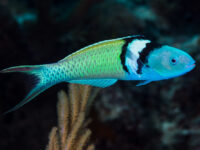Archaea are often described as “the weird organisms.” This is certainly apt, considering that they are a strange hybrid between the domain bacteria and the domain eukarya. Although it is important to note that not all archaea are extremophiles — organisms that live in and can withstand extreme conditions — many live in perfectly “normal” environments like lakes, soil, wetlands, and oceans.
Archaea share many similarities to bacteria — indeed, they were, for a long time, called “archaebacteria.” Both archaea and bacteria are unicellular, prokaryotic organisms, reproduce by binary fission, have genetic material and no membrane-bound organelles, and have flagella that aid their motility. However, they do possess several key differences, most notably in their membrane structure: while eukarya and bacteria have ester linkages, archaea have ether linkages. Additionally, archaea have a lipid monolayer instead of a bilayer that allows them to survive extreme environments. In many ways, they are actually more like eukaryotes than bacteria — for example, the enzymes involved in transcription and translation are more closely related. Archaea has since been recognized as its own domain of prokaryotes thanks to the work of Carl Woese and George Fox in 1977. Woese was the first person to argue that archaea had a distinct evolutionary line by sequencing fragments of 16s ribosomal RNA from every microorganism he could find. He used RNA “fingerprinting,” or separating fragments of RNA according to their nucleotide composition, which created a pattern of spots. From this, he found that archaea had a different pattern of spots than bacteria, implying that they belonged to a domain uniquely their own.
Not all archaea are extremophiles — organisms that live in and can withstand extreme conditions — many live in perfectly “normal” environments like lakes, soil, wetlands, and oceans.
Within the domain of archaea, there are currently four recognized phyla. Archaea are quite difficult to study, particularly because the medium they can grow on is unknown, and are — by extension — difficult to classify. The two best-known groups are euryarchaeota and crenarchaeota. Euryarchaeota includes many halophiles (salt-loving organisms) and methanogens (archaea that are anaerobic and produce methane gas). Interestingly, methanogens are a major cause of the methane that is released into the atmosphere. Some use the pigment retinal along with a protein to trap light energy and produce food, similar to how plants use chlorophyll. Crenarchaeota, on the other hand, includes a majority of known thermophiles, or heat-loving organisms. They are found in extremely hot or acidic environments. The other two groups are korarchaeota, which was discovered in a hot spring at Yellowstone in 1996 and live in hot springs and deep-sea hydrothermal vents, and nanoarchaeota, the most recently discovered archaea, which are some of the smallest organisms ever. However, many more phyla could exist, and with nanoarchaeota discovered recently in 2002, who knows what else is out there to discover?
Archaea are quite difficult to study, particularly because the medium they can grow on is unknown, and are — by extension — difficult to classify.
How do these extremophiles survive? Earlier on, it was mentioned that archaea’s membranes are mainly what sets them apart from other organisms. This is also what protects them. Take sulfolobus acidocaldarius, a species found in Yellowstone’s hot springs (as well as volcanic craters, deep-sea hydrothermal vents, and other acidic environments). To withstand the acidity, these organisms have a ringed molecule called calditol in their lipid membrane. Stanford researcher Paula Welander and her team identified three genes likely to be involved in making calditol and knocked them out (turning the gene off so that the proteins can’t be made). One of the genes, when mutated, resulted in S. acidocaldarius that lacked calditol in the membrane and withered in acidic conditions, implying that the protein associated with this gene was important to make the usual membrane and survive in acidic conditions. This finding was particularly revolutionary as the researchers were able to link a structural phenomenon to an environmental condition.
The archaea we see today are likely to be very closely related to the archaea that existed long ago!
So why are archaea so important? There are two main reasons: first, they play an important role in global geochemical cycling. Second, they are a valuable glimpse into our planet’s history. Due to the extreme environments they live in, archaea have evolved very little over the at least 2.7 billion years they’ve been around. The archaea we see today are likely to be very closely related to the archaea that existed long ago! In fact, Welander is looking broadly at understanding the major landmarks in Earth’s history like climate events, mass extinctions, and evolutionary transitions through studying these organisms. Overall, archaea is a very hot topic for research right now, and there is still so much that we don’t know.
Nature (2013). DOI: 10.1038/493610a






